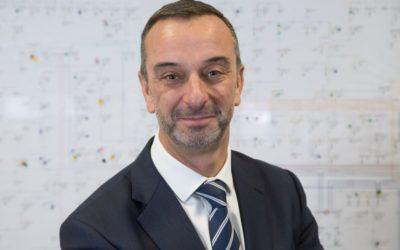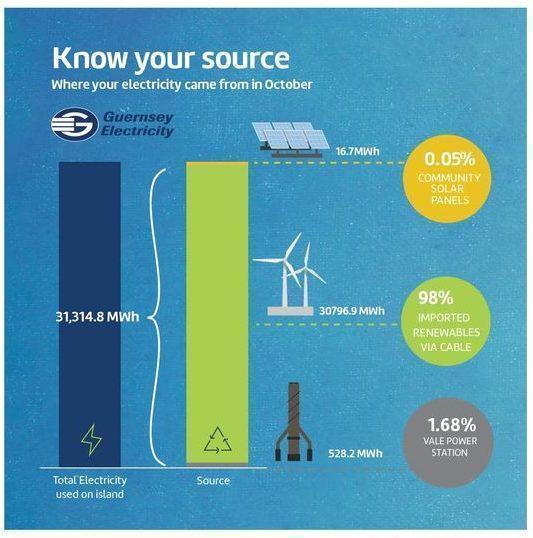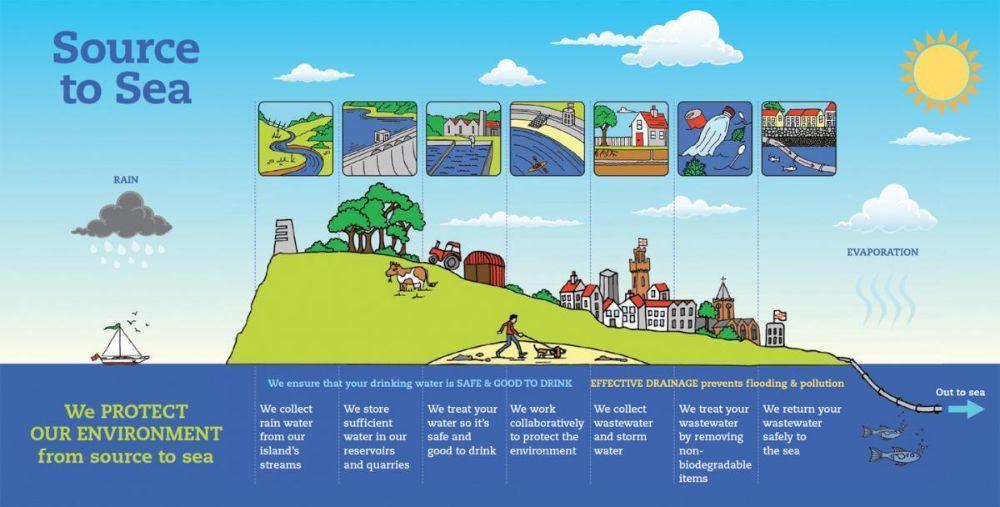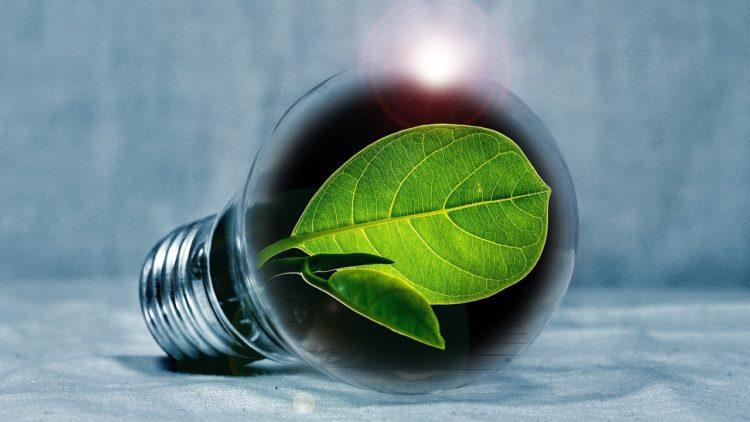In August this year, Guernsey’s government agreed to a 30-year energy strategy to reach net zero greenhouse gas emissions by 2050.
While the Climate Change Policy and Action Plan is not a legally binding commitment, like that made by the UK government just this week, it does mirror steps taken by other jurisdictions by laying out objectives including decarbonisation, energy independence and security of supply.
It also puts forward an ambitious ‘interim’ target of a 57% reduction on 1990 carbon emission levels over the next 10 years, and if Guernsey has any hope of achieving it, utility companies must play a leading role.
But responsibility doesn’t just fall on utility providers. The government must commit to creating infrastructure fit for a green transition, explains Guernsey Electricity CEO Alan Bates.
Channel Eye talks to the electricity provider, and Guernsey Water, about the biggest challenges facing utility companies in the next decade, and how they plan to help the island achieve its net zero goal.
Guernsey Electricity
Despite an unpredictable year, Guernsey Electricity remains firmly on its journey leading the energy transition, says its CEO, Alan Bates.

“Events over the last 12 months have brought into sharp focus the challenging yet exciting times ahead for Guernsey Electricity as we continue to strive to balance environmental sustainability with the delivery of a safe, stable, affordable energy supply.”
If anything, major milestones were hit in 2020.
Guernsey currently imports around 90% of its electricity from France. Previously, it was a mix of energy generated by nuclear and hydro but as of January, it was switched to 100% renewable energy sources such as solar, wind and hydro-electricity.
In addition, the company released a climate change statement, revised its environmental sustainability strategy, and retargeted its CSR programme to focus on environmental issues. This included the launch of Power to the People, a community fund offering support for initiatives that support the UN’s sustainable development goals.
‘We understand our role’
The company has initiated these changes partly as a response to a shift in public awareness around environmental issues, Alan says, but also because Guernsey Electricity, as an energy provider, has a responsibility to lead by example when it comes to sustainability.
“We understand our role and how we can help tackle climate change for our society. That’s why we published our climate change statement earlier to set out our commitment to environment”, says Alan, who’s been Guernsey Electricity’s CEO for 10 years.

“We believe in renewables for all, not just those who are fortunate to have the time, space and resources to install domestic scale renewables.
“We are aware that our customers want to know more about where their electricity comes from. Since March, we have started to publish a monthly breakdown of our electricity sources on social media to help explain this to our customers.
“We have also experienced unprecedented demand and interest in switching to electric heating as customers look to reduce their carbon footprint.”
Current regulation of the electricity market must be reviewed
The way utilities operate and changing consumer behaviour are just pieces of the jigsaw puzzle – they cannot achieve Guernsey’s green transition alone. There must be political commitment and a fit-for-purpose infrastructure.
“We would encourage the States to embrace its new Energy Policy and actively work with the energy industry and consumers in order to achieve its ambitious energy transition targets.”
So, what are the biggest challenges to implementing Guernsey Electricity’s sustainability strategy?
“We would encourage the States to embrace its new Energy Policy and actively work with the energy industry and consumers in order to achieve its ambitious energy transition targets.
“We believe that a fundamental review of the current regulation of the electricity market is key to develop proportionate and value adding energy regulation to deliver the Energy Policy.
“Our current tariff structure has the potential to not fairly recovery costs from customers and are therefore not fit for purpose for the energy transition. We must fix this for the benefit of islanders and the environment”, Alan explains.
“Guernsey Electricity believes complete transparency needs to be provided on the costs to provide a reliable and secure electricity infrastructure for the island. By doing this, customers can make the right investment decisions by understanding how much electricity as a commodity actually costs from the different generation sources. This transparency will enable us, as a community, to focus on how we can best achieve our environmental and economic expectations affordably”.
The long-term strategy: a new direct cable from France
Before 2000, St Sampson’s power station was the island’s only source of electricity, generating power 24 hours a day, 365 days a year – all from fossil fuels. Guernsey Electricity’s journey to become carbon neutral started with the installation of the subsea cable between Jersey and Guernsey, GJ1, which provides 100% of Guernsey’s energy needs in summer and around 75% in winter.
This means the power station is still required as a top-up for winter peak periods and as a back-up, in case the supply from the cable goes down, which happened as recently as 2018 to 2019.
“Even before the pandemic became the number one factor impacting every business, Guernsey Electricity was going through an extremely busy and at times, turbulent time”, says Alan Bates, CEO of Guernsey Electricity.
“Last year, we replaced the subsea cable, which included procurement, manufacture, installation and putting it into service in just nine months, to mitigate the significant environmental impacts of an unreliable cable.”
Guernsey Electricity is now pursuing a direct connection to France to increase long term resilience and sustainability. The link, which it wants in place by mid-2020s, could fulfil around 99% of the island’s electricity demands and, over its lifetime, save 600 kilotons of CO2 from being released in to the atmosphere.
“Guernsey’s Energy Policy, set out in June, has provided a clear vision for the future, which supports the need for a second import cable. We are currently focusing on developing the business case which is due to submitted to the States in 2021”, Alan said.
“The installation of a second importation cable from France will support local renewables and see a future where the power station is used for emergency generation only.”
Guernsey Water

As one of the Guernsey’s largest electricity users, Guernsey Water has a significant responsibility to manage its environmental impact.
As part of its 10 year business plan, launched in 2016, the company names protecting the environment as one of its six desired key outcomes. A spokesperson for Guernsey Water discusses how its environmental ambitions are being realised.
What are the biggest challenges to managing your environmental impact?
One of the biggest challenges we face is our consumption of power and chemicals.
Our current project to return to a conventional treatment process at St Saviour Water Treatment Works will reduce the level of energy used to produce drinking water. We have already carried out a similar development by refurbishing the Juas Water Treatment Works in the Vale and decommissioning the Longue Hougue Water Treatment Works.
In the last four years, what have been the significant achievements in support of Guernsey Water’s ‘Protect our Environment’ business plan outcome?

- We recently committed to cease using herbicides on our sites to help protect the environment and also pollution prevention.
- One example of working towards better surface water management is our Sustainable urban Drainage System (SuDS) project at Vauvert School, which reduces the quantity and speed of the surface water flowing into the foul water network. This has allowed us to further consider how this may be extended across the Island on a larger scale.
- We support schools and sports events where possible through the provision of a temporary refill station. Guernsey Water is also signed up to the water refill app that highlights locations across the Island where the public can refill their water bottle free of charge.
- We have engaged with some of the island’s primary schools to educate students on where our water comes from, how it becomes safe and good to drink, what not to flush into our drainage network and how we safely dispose of our wastewater back into the sea.
Our Biodiversity Strategy has seen many positive initiatives come to fruition, notably:
- 200 trees planted with Guernsey Trees for Life at four Guernsey Water sites across the Island. The trees and shrubs planted are all native species – English oak, hawthorn and hazel
- Developed 11 Guernsey Water sites in conjunction with the Pollinator Project to encourage flora, fauna and other wildlife
- Reduced cutting of grassland areas and hedges, leaving borders and hedgerow for longer to support nesting birds and insects
- Installed bird boxes, reed beds, planted additional trees and cut grassland in rotation. Cuttings are composted on site where possible
- Grasslands allowed to develop into wildflower meadows over the summer months
- Joint work with Environment Guernsey to monitor biodiversity growth and to seek guidance on the optimum timings for work to be carried out
- Installation of an osprey nesting platform at the reservoir in collaboration with La Société Guernesiaise
The work as outlined above has seen an improvement in the number of species of native wildlife identified in these areas, which include:
- Spanish bluebells
- Black oil beetles
- Slow worms
- Glanville Fritillary butterflies
- Black-backed meadow ants.
The ant, in particular, had shown a 42% decline in numbers since the 1990s and the species is only found in Guernsey and Jersey in the British Isles.
200 trees – English oak, hawthorn and hazel – planted at four Guernsey Water sites across the island will help contribute to offsetting the Island’s carbon footprint for years to come.
Looking ahead to the next five years, what are expected to be the biggest environmental projects?

- As part of our biodiversity plan, we are focussing on how we can make more of our sites accessible and enable recreational use. The Millennium Walk development at St Saviour’s reservoir is just about to start which will making part of the trail accessible for everyone, as well as creating an outdoor learning space, ensuring that it works in harmony with nature. The company believes it is important that the natural environment is used for Islanders’ health and wellbeing.
- As one of the Island’s largest electricity users, a significant project will be the electrification of our vehicle fleet, as working towards reducing our greenhouse gas emissions to help meet the targets set out in the States of Guernsey Climate Change Policy and action plan.
- Reducing the use of plastic waste is something we are passionate about and working with Refill Guernsey we have plans to install three to four water refill stations across the island next year.
How has Guernsey Water ensured that waste production and consumption of resources is minimised within its office environment?
Guernsey Water reduces paper usage wherever possible as well as having designated waste facility throughout the office. The lighting throughout the office is installed with sensors which helps with energy saving, and as mentioned above a large project will be the electrification of our vehicle fleet.














